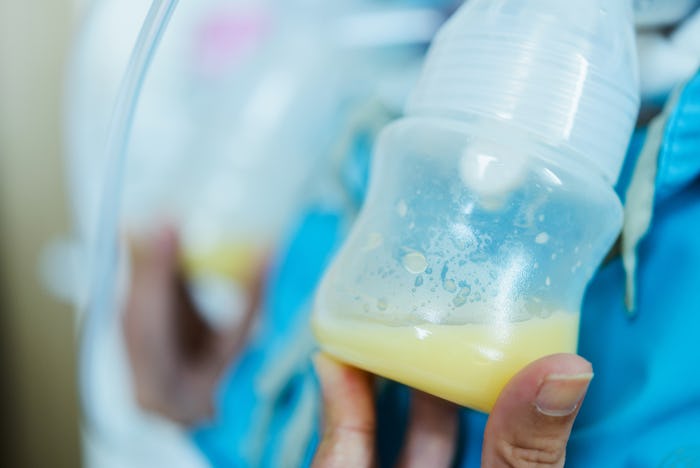Life

5 Reasons Your Breast Milk Is A Different Color, According To Science
A mother's body is incredible, capable of extraordinary things in order to accommodate a new baby. Breast milk, for instance, provides all the nutrients your infant needs for the first six months of his or her life. And while formula babies can (and do!) receive similar benefits, breast milk has the ability to change in composition according to, and in anticipation of, your baby's specific needs. So, as you can probably imagine, there are more than a few reasons why your breast milk is a different in color, according to science. The changes may be subtle, but they're part of a role your body plays in sustaining, and nurturing, your growing infant.
According to a 2013 study published in Clinical and Translational Immunology, colostrum — the nutrient dense super milk your body first produces during pregnancy — can and usually does spike if there's any signs of possible illness threatening either you or your baby. In other worse, this "spike" is a natural defense mechanism. Likewise, your colostrum changes throughout the course of pregnancy, birth, and beyond. For example, it may be yellowish, creamy in color, and thicker than the milk your body makes later in your breastfeeding journey and as your breast milk naturally thins over time.
The American Pregnancy Association (APA) reported that, typically, colostrum is replaced by transitional milk two to four days after birth. That's why, among many other reasons, colostrum reappearing at a time when you or baby show signs of illness is a pretty damn incredible occurrence. And if you think that's amazing, here are some other reasons your breast milk may differ in color, according to science.
You've Just Given Birth
Again, your breast milk will be thicker than usual following childbirth. KidsHealth.org suggests frequent feedings to stimulate milk production while our colostrum gives your newborn what they need. And as you experience your first few days as a new mom, your colostrum will transition from the thick, yellowish pre-milk formula to a thinner, mature milk. The color will turn whiter and as long as you're feeding often.
You're Feeding Regularly
When you've established a regular feeding schedule, and the colostrum has subsided, the color of your breast milk should mostly be of the white variety. Building a strong, healthy milk supply doesn't happen with luck, but with practice and patience. Once the colostrum and transitional milk (colostrum mixed with mature milk) phase out, Babble says your baby will respond to the higher volume of milk by swallowing the thinner, whiter milk more frequently. This is the mature milk that will be there for the long haul and consists of fore-milk (happens at the start of a feeding and contains water, vitamins and protein) and hind-milk — which as higher levels of fat and is essential for weight gain, according to the APA.
Your Baby Is Sick
Dr. Jamil Abdur-Rahman, board-certified OB-GYN and Chairman of Obstetrics and Gynecology at Vista East Medical Center in Waukegan, Illinois, tells Self that not only is it possible for breast milk to change when mom or baby falls ill, it's likely.
According to Abdur-Rahman, breast milk appearance and color changes because "the percentage of infection-fighting white blood cells [found in the breast milk] increases up to 94 percent, more closely resembling the white blood cell composition found in colostrum." Though, it should also be noted breast milk color and consistency doesn't only change with impending illness. Self adds the changes can happen due to dehydration, diet, vitamins, and the result of certain medications.
Your Nipples Are Cracked
When breastfeeding, you might experience sore and/or cracked nipples. With that said, if your milk has a reddish or pinkish tint, Infant Risk Center — part of Texas Tech University Health and Sciences Center — says that there are two main reasons for the discoloration. The first reason could be a broken or ruptured capillary in the breast or nipple. It sounds painful, but won't cause any harm. The second could be due to a bacterium called Serratia marsescens — a common bacterium that's generally harmless.
However, because either might suggest something more serious, you should get checked by your physician before continuing to breastfeed.
You've Changed Breasts Too Soon, Or Baby's Needs Changed
It's not always easy to tell if you've "emptied" one breast and need to move to the other , but sometimes switching too early will leave you with thin, watery milk — the fore-milk — as opposed to the hind-milk.
Plus, your breast milk is specially formulated to address your baby's needs, so if the color or consistency change, it could be due to your baby's changing needs, too. Breastfeeding Basics and International Board Certified Lactation Consultant Anne Smith says breast milk is adaptable, coming in shades of whites to brownish hues. It's made differently for preemies and toddlers alike, and even changes texturally in warm weather. Basically, breastfeeding (any amount of breast milk) is an amazing super power.
Check out Romper's new video series, Romper's Doula Diaries:
Watch full episodes of Romper's Doula Diaries on Facebook Watch.